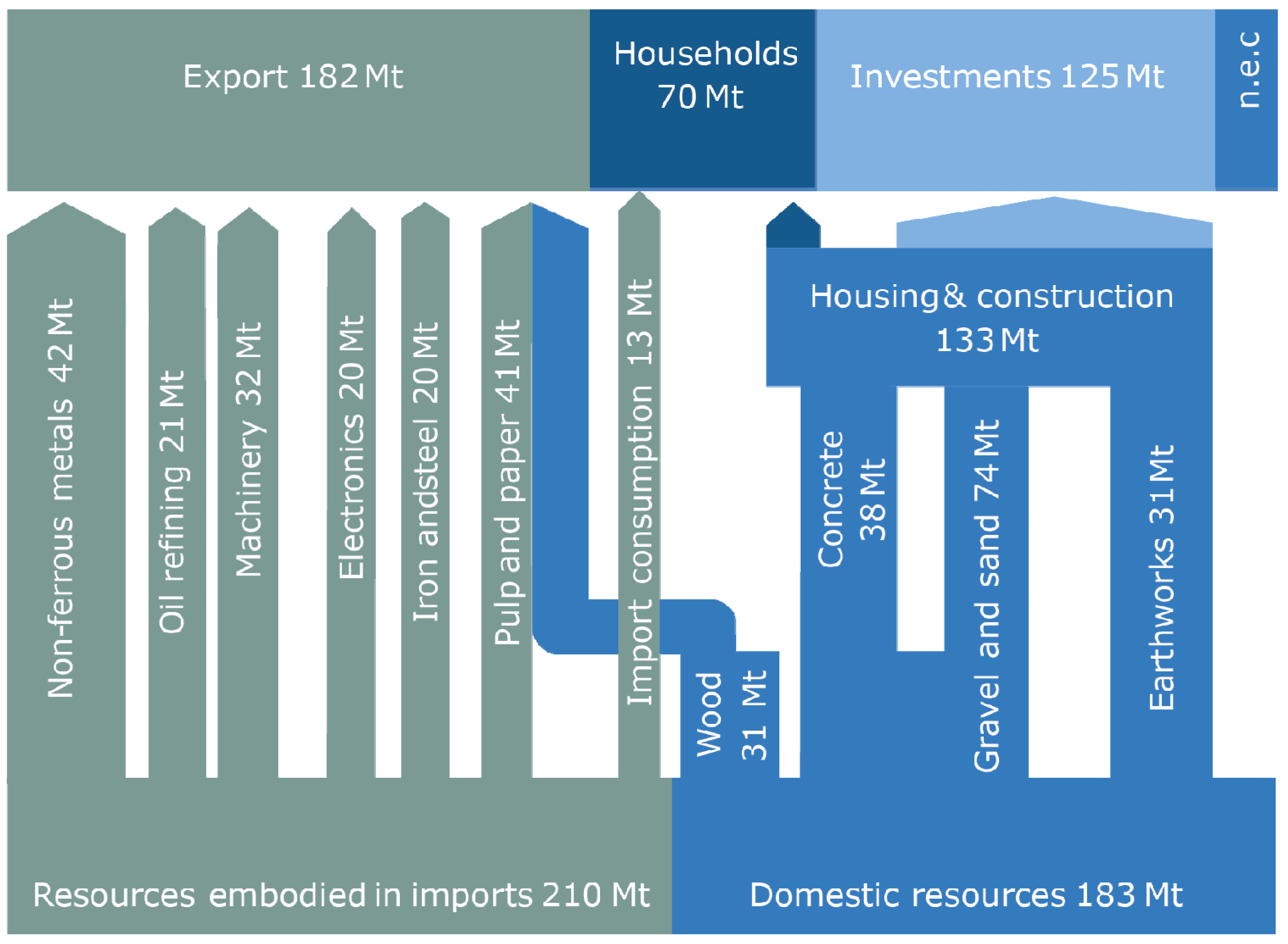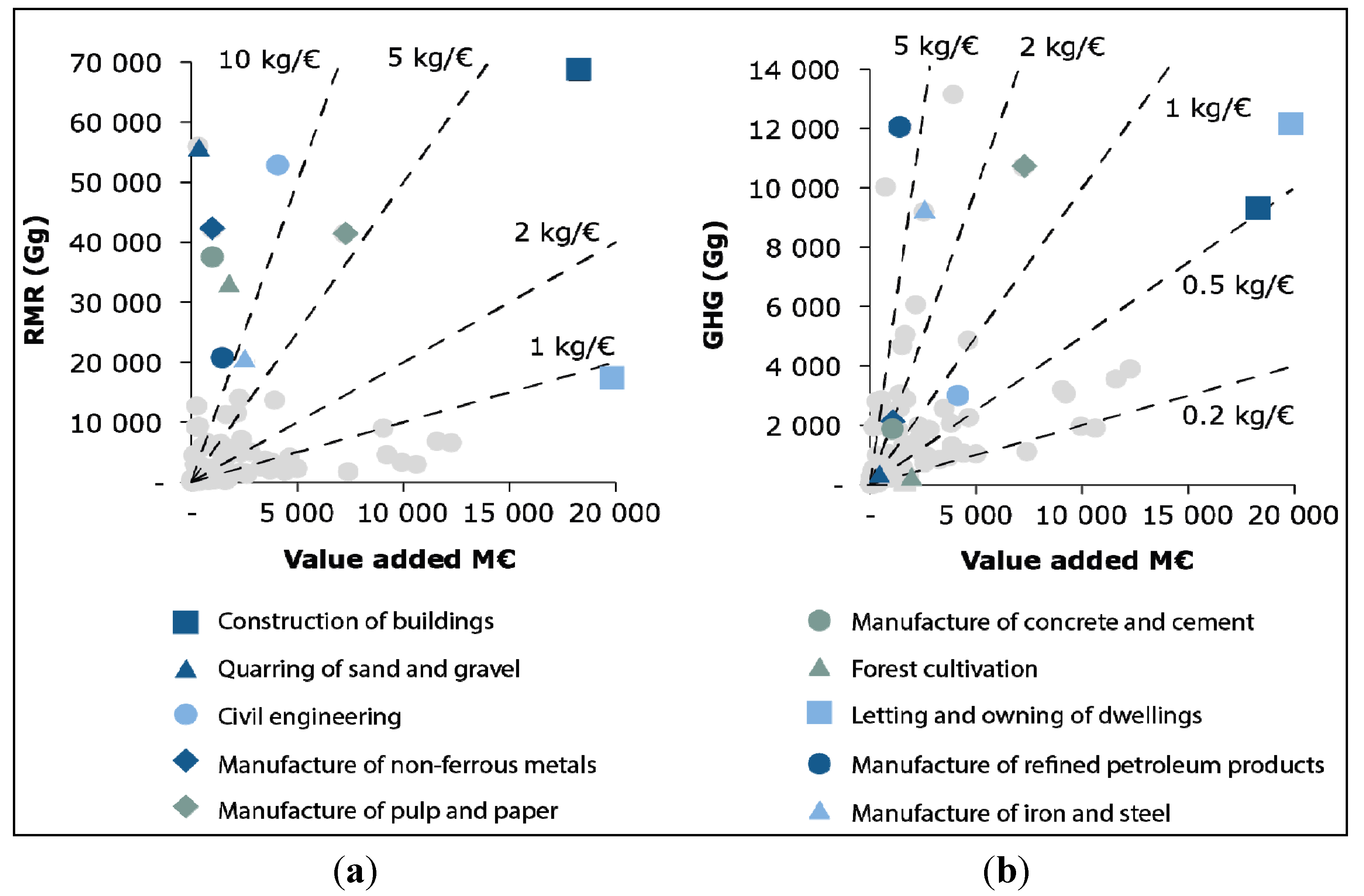Identifying Key Sectors and Measures for a Transition towards a Low Resource Economy
Abstract
:1. Introduction
2. Materials and Methods
2.1. Material Flow Indicators and MIPS

2.2. Material/Resource Intensities at the Economy Level with EEIO Models


2.3. Identification of Key Sectors through Total Flow Analysis


 is a diagonal matrix of a direct material intensity vector [kg/€].
is a diagonal matrix of a direct material intensity vector [kg/€].
 is a diagonal matrix of the total material intensity vector [kg/€].
is a diagonal matrix of the total material intensity vector [kg/€].  of the total material flow matrix describes how much material flow is embodied in the purchase of input i to sector j. Therefore, the matrix can be used to construct a flow diagram of the economy based on accumulative material burden (or a rucksack, to use the original MIPS terminology).
of the total material flow matrix describes how much material flow is embodied in the purchase of input i to sector j. Therefore, the matrix can be used to construct a flow diagram of the economy based on accumulative material burden (or a rucksack, to use the original MIPS terminology). 3. Results and Discussion
3.1. The Key Sectors and Main Pathways of Resource Use in Finland
| NACE1 | Industry | RMR (Gg) |
|---|---|---|
| 4501 | Construction of residential buildings | 68.5 |
| 142 | Quarrying of sand and clay | 56.0 |
| 4502 | Civil engineering | 52.6 |
| 274 | Manufacture of non-ferrous metals | 42.2 |
| 211 | Manufacture of pulp, paper and paperboard | 41.4 |
| 266 | Manufacture of concrete and cement | 37.5 |
| 0211 | Forest cultivation | 32.5 |
| 232 | Manufacture of refined petroleum products | 21.0 |
| 271 | Manufacture of iron and steel | 20.1 |
| 7021 | Letting and owning of dwellings | 17.4 |
| Average sector | 4.8 |

3.2. Material/Resource Intensities of the Industries


3.3. Measures towards a Low Resource Economy
| Production | Investments on infrastructure |
|---|---|
|
|
| Services | Consumption |
|
|
4. Conclusions
References
- European Commission. A Resource-Efficient Europe-Flagship Initiative under the Europe 2020 Strategy; COM(2011)21. Available online: http://ec.europa.eu/resource-efficient-europe/pdf/resource_efficient_europe_en.pdf (accessed on 27 June 2013).
- Antikainen, R.; Mickwitz, P.; Seppälä, S.; Virkamäki, V.; Leppänen, M.; Hujala, T.; Riala, M.; Nummelin, T.; Paavilainen, L.; Vihinen, H.; et al. Opportunities for Green Growth [In Finnish with English abstract]; Prime Minister’s Office Reports 4/2013: Helsinki, Finland, 2013; Available online: http://vnk.fi/julkaisukansio/2013/r04-vihrean-kasvun/PDF/fi.pdf (accessed on 27 June 2013).
- Kowalski, M.; Swilling, M.; von Weizsäcker, E.U.; Ren, Y.; Moriguchi, Y.; Crane, W.; Krausmann, F.; Eisenmenger, N.; Giljum, S.; Hennicke, P.; et al. Decoupling Natural Resource Use and Environmental Impacts from Economic Growth; United Nations Environment Programme (UNEP): Geneva, Switzerland, 2011; A Report of the Working Group on Decoupling to the International Resource Panel. [Google Scholar]
- Dittrich, M.; Giljum, S.; Lutter, S.; Polzin, C. Green Economies around the World? Implications of Resource Use for Development and Environment; Sustainable Europe Research Institute (SERI): Vienna, Austria, 2012; Available online: http://www.boell.de/downloads/201207_green_economies_around_the_world.pdf (accessed on 27 June 2013).
- The Factor 10 Institute. Available online: http://www.factor10-institute.org/ (accessed on 28 June 2013).
- Robèrt, K.H.; Schmidt-Bleek, B.; Aloisi de Larderel, J.; Basile, G.; Jansen, J.L.; Kuehr, R.; Price Thomas, P.; Suzuki, M.; Hawken, P.; Wackernagel, M. Strategic sustainable development—Selection, design and synergies of applied tools. J. Clean. Prod. 2002, 10, 197–214. [Google Scholar] [CrossRef]
- European Commission, Eurostat. Resource Productivity by Countries. 2009. Available online: http://epp.eurostat.ec.europa.eu/statistics_explained/index.php?title=File:Resource_Productivity_by_countries,_2009_%28EUR_per_kg%29.png&filetimestamp=20120809145542 (accessed on 16 April 2013).
- National Accounts, Gross Domestic Product by Industry (TOL 2008), %. Available online: http://www.stat.fi/tup/suoluk/suoluk_kansantalous_en.html (accessed on 9 April 2013).
- Programme of Prime Minister Jyrki Katainen’s Government. Prime Minister’s Office: Helsinki, Finland, 22 June 2011. Available online: http://valtioneuvosto.fi/hallitus/hallitusohjelma/pdf/en334743.pdf (accessed 24 April 2013).
- Bringezu, S.; Schütz, H.; Steger, S.; Baudisch, J. International comparison of resource use and its relation to economic growth. The development of total material requirement, direct material inputs and hidden flows and the structure of TMR. Ecol. Econ. 2004, 51, 97–124. [Google Scholar] [CrossRef]
- Hinterberger, F.; Schmidt-Bleek, F. Dematerialization, MIPS and Factor 10. Physical sustainability indicators as a social device. Ecol. Econ. 1999, 29, 53–56. [Google Scholar] [CrossRef]
- Ritthoff, M.; Rohn, H.; Liedtke, C. Calculating MIPS. Resource Productivity of Products and Services. Wuppertal Spezial 27e; Wuppertal Institute for Climate, Environment and Energy: Wuppertal, Germany, 2002. [Google Scholar]
- Economy Wide Material Flow Accounts and Derived Indicators (Edition 2000). A Methodological Guide; Eurostat, European Communities: Luxembourg, 2001.
- Economy-Wide Material Flow Accounts (EW-MFA). Compilation Guide 2012; Eurostat, European Communities: Luxembourg, 2012.
- Schoer, K.; Weinzettel, J.; Kovanda, J.; Giegrich, J.; Lauwigi, C. Raw material consumption of the European Union—Concept, calculation method, and results. Environ. Sci. Tech. 2012, 46, 8903–8909. [Google Scholar] [CrossRef]
- Mancini, L.; Lettenmeier, M.; Rohn, H.; Liedtke, C. Application of the MIPS method for assessing the sustainability of production-consumption systems of food. J. Econ. Behav. Organ. 2012, 81, 779–793. [Google Scholar]
- Suh, S. Handbook of Input-Output Economics in Industrial Ecology; 2nd Printing; Springer: Dordrecht, Germany, 2009. [Google Scholar]
- Seppälä, J.; Mäenpää, I.; Koskela, S.; Mattila, T.; Nissinen, A.; Katajajuuri, J.M.; Härmä, T.; Korhonen, M.R.; Saarinen, M.; Virtanen, Y. An assessment of greenhouse gas emissions and material flows caused by the Finnish economy using the ENVIMAT model. J. Clean. Prod. 2011, 19, 1833–1841. [Google Scholar] [CrossRef]
- Koskela, S.; Mäenpää, I.; Seppälä, J.; Mattila, T.; Korhonen, M.-R. EE-IO modeling of the environmental impacts of Finnish imports using different data sources. Ecol. Econom. 2011, 70, 2341–2349. [Google Scholar] [CrossRef]
- Eurostat Manual of Supply, Use and Input-Output Tables; Eurostat: Luxembourg, 2008; Available online: http://epp.eurostat.ec.europa.eu/cache/ITY_OFFPUB/KS-RA-07-013/EN/KS-RA-07-013-EN.PDF (accessed on 28 January 2013).
- Ecoinvent Database v.2.2. Swiss Centre for Life Cycle Inventories; Ecoinvent. 2010. Available online: http://www.ecoinvent.org (accessed on 28 January 2013).
- Faostat Web Page. Available online: http://faostat.fao.org/ (accessed on 28 January 2013).
- Timmer, M. The World Input-Output Database (WIOD): Contents, Sources and Methods. 2012. Available online: http://www.wiod.org/database/index.htm (accessed on 7 June 2013).
- Lenzen, M. Errors in conventional and input-output-based life-cycle inventories. J. Ind. Ecol. 2001, 4, 127–148. [Google Scholar] [CrossRef]
- Oosterhaven, J. On the Definition of Key Sectors and the Stability of Net versus Gross Multipliers; Research Report 04C01; University of Groningen: Groningen, The Netherlands, 2004. [Google Scholar]
- Szyrmer, J.M. Measuring connectedness of input-output models: 2. Total flow concept. Environ. Plan. A 1986, 18, 107–121. [Google Scholar]
- Wood, R.; Lenzen, M. Aggregate measures of complex economic structure and evolution. J. Ind. Ecology 2009, 13, 264–283. [Google Scholar] [CrossRef]
- Lenzen, M. Environmentally important paths, linkages and key sectors in the Australian economy. Struct. Change Econ. Dyn. 2003, 14, 1–34. [Google Scholar] [CrossRef]
- Mattila, T. Any sustainable decoupling in the Finnish economy? A comparison of the pathways and sensitivities of GDP and ecological footprint 2002–2005. Ecol. Indic. 2012, 16, 128–134. [Google Scholar] [CrossRef]
- Material Intensity Factors, Overview on Materials, Fuels, Transport Services and Food. Available online: http://wupperinst.org/uploads/tx_wupperinst/MIT_2011.pdf (assessed on 25 April 2013).
- Martens, P.; Rotmans, J. Transitions in a globalising world. Futures 2005, 37, 1133–1144. [Google Scholar] [CrossRef]
- Geels, F.W.; Kemp, R. Dynamics in socio-technical systems: Typology of change processes and contrasting case studies. Technol. Soc. 2007, 29, 441–445. [Google Scholar] [CrossRef]
- Bergek, A.; Jacobsson, S.; Carlsson, B.; Lindmark, S.; Rickne, A. Analyzing the functional dynamics of technological innovation systems: A scheme of analysis. Res. Policy 2008, 37, 407–429. [Google Scholar] [CrossRef]
- Meadows, D.H. Thinking in Systems. Chapter Six: Leverage Points: Places to Intervene in a System; Chelsea Green Publishing Company: White River Junction, VT, USA, 2008; pp. 145–165. [Google Scholar]
- Europan Environment Agency. Survey of Resource Efficiency Policies in EEA Member and Cooperating Countries. Available online: http://www.eea.europa.eu/themes/economy/resource-efficiency/germany-2014-resource-efficiency-policies (accessed on 27 June 2013).
- The International Organization for Standardization (ISO), Environmental Management, Material Flow Cost Accounting, General Framework; ISO 14051:2011; ISO: Geneva, Switzerland, 2011.
- Schnieders, J.; Hermelink, A. DEPHEUS results: Measurements and occupant’s satisfaction provide evidence for passive houses being an option for sustainable building. Energy Policy 2006, 34, 151–171. [Google Scholar] [CrossRef]
- Mont, O.; Plepys, A. Sustainable consumption progress: Should we be proud or alarmed? J. Clean. Prod. 2008, 16, 531–537. [Google Scholar] [CrossRef]
- Hislop, H.; Hill, J. Reinventing the Wheel: A Circular Economy for Resource Security; Green Alliance: London, UK, 2011. [Google Scholar]
© 2013 by the authors; licensee MDPI, Basel, Switzerland. This article is an open access article distributed under the terms and conditions of the Creative Commons Attribution license (http://creativecommons.org/licenses/by/3.0/).
Share and Cite
Koskela, S.; Mattila, T.; Antikainen, R.; Mäenpää, I. Identifying Key Sectors and Measures for a Transition towards a Low Resource Economy. Resources 2013, 2, 151-166. https://doi.org/10.3390/resources2030151
Koskela S, Mattila T, Antikainen R, Mäenpää I. Identifying Key Sectors and Measures for a Transition towards a Low Resource Economy. Resources. 2013; 2(3):151-166. https://doi.org/10.3390/resources2030151
Chicago/Turabian StyleKoskela, Sirkka, Tuomas Mattila, Riina Antikainen, and Ilmo Mäenpää. 2013. "Identifying Key Sectors and Measures for a Transition towards a Low Resource Economy" Resources 2, no. 3: 151-166. https://doi.org/10.3390/resources2030151




